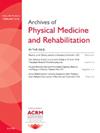National Intensive Evaluation and Treatment Program (IETP) for Persons With Mild to Moderate Traumatic Brain Injury (TBI) 8269
IF 3.6
2区 医学
Q1 REHABILITATION
Archives of physical medicine and rehabilitation
Pub Date : 2025-04-01
DOI:10.1016/j.apmr.2025.01.019
引用次数: 0
Abstract
Objectives
An evidence-based approach characterized an inpatient national Intensive Evaluation and Treatment Program (IETP) for service members and veterans with mild to moderate traumatic brain injury (TBI). This work illustrates IETP characterization, determinants, mechanisms, and outcomes that influence implementation.
Design
A concurrent mixed methods evaluation design using a participatory approach was implemented to characterize the program and understand implementation. Methods and analytics were guided by implementation science frameworks including the Consolidated Framework for Implementation Research and RE-AIM.
Setting
IETP is delivered in an interdisciplinary comprehensive TBI inpatient rehabilitation, peer supported setting within Veterans Affairs.
Participants
Participants included program key informants (n=12), IETP patients (n=47), DoD referral representatives (n=13), focus groups with IETP teams (n=8), and site observations (n=5).
Interventions
The intervention being characterized, IETP, is an interdisciplinary evidence-based comprehensive TBI inpatient rehabilitation program, in concordance with existing guidelines for TBI and common co-occurring comorbidities.
Main Outcome Measures
Key informant interviews, patient interviews, DoD referral representative interviews, focus groups with IETP teams, and site observations were used to complete aims.
Results
IETP is an innovative, interdisciplinary evidence-based comprehensive inpatient rehabilitation program, as defined by the delivery of integrated patient-centered rehabilitation services to improve higher-level functioning, well-being, and brain health for eligible service members and veterans with a complex history of mild to moderate TBI. IETP provides integrated services to manage physical injuries, posttraumatic stress disorder, and/or emotional dysregulation to improve health and wellness, including outcomes associated with pain, function, participation, and mental health. Although IETP is a national program, findings indicate each site has unique attributes such as program length, specialty services, staffing, space, and equipment. Analyses and stakeholder feedback resulted in identification of IETP-specific determinants including: intervention characteristics, characteristics of the individual, inner setting, process, and outer setting. Data informed identification of implementation strategies, patient- and site-level mechanisms, and outcomes.
Conclusions
Data informed IETP characterization, who the program serves, determinants, mechanisms, and outcomes. Recommendations can inform program implementation and adaptations that could enhance IETP implementation and outcomes.
This work was funded by the Veterans Health Administration Health Services Research and Development Partnered Evaluation Center (PEC 21-129) through the Quality Enhancement Research Initiative and Research Career Scientist Award (RCS 17-297). IRBNet #1627569-3. This work was supported with resources, facilities and personnel at James A. Haley Veterans’ Hospital Research Service and VA HSR&D Informatics, Decision-Enhancement, and Analytic Sciences Center of Innovation (CIN 13-414). Contents do not represent views of the Department of Veterans Affairs of the United States Government.
Disclosures
none.
求助全文
约1分钟内获得全文
求助全文
来源期刊
CiteScore
6.20
自引率
4.70%
发文量
495
审稿时长
38 days
期刊介绍:
The Archives of Physical Medicine and Rehabilitation publishes original, peer-reviewed research and clinical reports on important trends and developments in physical medicine and rehabilitation and related fields. This international journal brings researchers and clinicians authoritative information on the therapeutic utilization of physical, behavioral and pharmaceutical agents in providing comprehensive care for individuals with chronic illness and disabilities.
Archives began publication in 1920, publishes monthly, and is the official journal of the American Congress of Rehabilitation Medicine. Its papers are cited more often than any other rehabilitation journal.

 求助内容:
求助内容: 应助结果提醒方式:
应助结果提醒方式:


